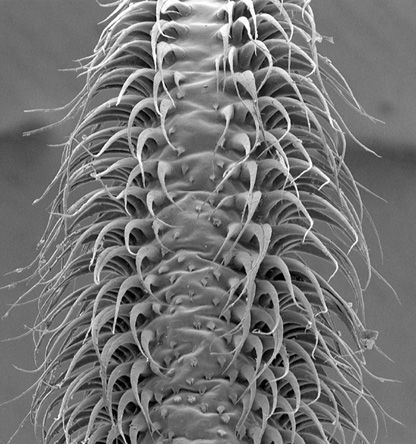
(ISNS) -- A bat that uses blood flow to reshape its tongue while feeding could help inspire the development of shape-shifting medical instruments, according to a new study.
Scientists have known for a long time that the tongue of the nectar-feeding bat Glossophaga soricina was covered with tiny hairs, but these structures were considered to be passive and unable to move on their own, like the strings of a floor mop. The hairs were thought to have developed as a means of increasing the tongue's surface area to help the bat gather nectar as quickly and efficiently as possible.
Recently, however, scientists at Brown University in Providence, R.I., decided to take another look at the bat's tongue. They were prompted by another study, which found that, contrary to nearly 200 years of conventional wisdom, the tongues of hummingbirds are dynamic structures.
"Hummingbirds have forked tongues that are supported by two [protein-reinforced] rods," explained Cally Harper, a graduate student in ecology and evolutionary biology at Brown University in Providence, R.I.
"During nectar-feeding, the rods separate from each other once the tongue is submerged in nectar. As the tongue is withdrawn, nectar is trapped within and between the tongue tips," said Harper.
In a new study published in this week's issue of the journal Proceedings of the National Academy of Sciences, Harper and her team reanalyzed the tongue of G. soricina and discovered a previously unknown network of veins and arteries that are associated with the tiny hairs on the tip of the bat's tongue.
"When we saw this, we hypothesized that the hairs on the tongue tip might fill with blood and become erect during nectar feeding," said Harper.
Sign up for the Live Science daily newsletter now
Get the world’s most fascinating discoveries delivered straight to your inbox.
The team's suspicions were supported by experiments on excised bat tongues in which they were able to erect the hairs – known as papillae – by pumping saline into the blood vessels.
But the "aha" moment came after the team recorded high-speed videos of the tongues morphing as the animals fed on nectar. This confirmed that the tongues actually changed shape in live bats.
The tongue tip becomes engorged with blood in 0.04 seconds – too fast to glimpse with the unaided eye.
But a high-speed camera capturing 500 video frames per second revealed that as the tongue protrudes from the bat's mouth, the hairs are resting flat against the tongue. Only when the tongue is completely outstretched and the tongue tip fills with blood do the papillae flare out, perpendicular to the axis of the tongue. As the hairs fill with blood, they change color, from light pink to bright red.
In their erect state, the hairs not only add exposed surface area, but also width, thereby increasing the overall effectiveness of the tongue as a nectar mop.
Kurt Schwenk, an expert in the anatomy and mechanics of tongues at the University of Connecticut, in Storrs, called the research "outstanding."
"The authors have not only discovered a remarkable piece of natural history, they've revealed the bats' feeding mechanism with amazing clarity and beautiful imagery," said Schwenk, who was not involved in the study. "The paper is really a gem and it's something I will want my students to study as an example of excellent science."
Schwenk noted that geckos also inflate their tongue papillae when cleaning their eyes, but the effect is not nearly as dramatic as in bats. He thinks there are other amazing, dynamic tongues in nature that await discovery, perhaps among marsupials that also feed on nectar, using brush-like tongues.
The sheer number of weird and wonderful animal tongues that exist not only make them ideal systems for studying evolution, scientists say, but also great sources of inspiration for future surgical tools and medical robots.
"Tools modeled after bat tongue tips would be beneficial because they would be flexible – and therefore able to bend and conform to the curves of blood vessels and intestines – and able to simultaneously change length and surface configuration," said Harper.
Cang Lam, a California-based medical engineer, agreed. The shape-shifting bat tongue could be used as a model for devices able to wind through small blood vessels and then later change shape, from straight and narrow to a circular brush.
"One device I can immediately think of is a clot retriever for stroke patients," said Lam, who also did not participate in the research.
Ker Than is a freelance writer based in Southern California.
Inside Science News Service is supported by the American Institute of Physics.












